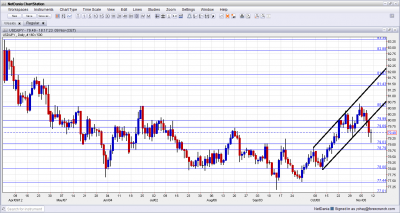Dollar/yen fell as safe haven flows poured into the Japanese yen. GDP, Tertiary Industry Activity and Masaaki Shirakawa’s speech are the main market-movers this week. Here’s an outlook for the Japanese events and an updated technical analysis for USD/JPY.
The re-election of Obama was eventually greeted with a drop in stock markets and gains for the US dollar and the Japanese yen, with the latter winning against the former. Also the drop in US yields pushed the pair lower. Last week Japan’s core machinery orders deteriorated more than expected falling 4.3% in September after a 3.3% decline in August, adding another warning sign that the world’s third-largest economy is slipping into recession. Global economic slowdown as well as rising tensions with China and weakening domestic demand reduced the nation’s current account surplus. Moreover, economists forecast a 0.9% contraction in the third quarter with continued sluggishness for the rest of this year.
Updates: Preliminary GDP declined 0.9%, just below the estimate of a 0.8% drop. Tertiary Industry Activity climbed 0.3%, beating the forecast of 0.0%. CGPI declined 1.0%, below the estimate of -0.8%. Preliminary GDP Price Index dropped 0.7%, matching the market forecast. BOJ Governor Masaaki Shirakawa spoke at a meeting in Tokyo. Preliminary Machine Tool Orders dropped sharply, declining by 6.7%. Revised Industrial Production fell 4.1%, matching the estimate. The yen is weakening, as USD/JPY was trading at 79.53. There are no releases scheduled on Thursday or Friday. The yen continues to drop, as USD/JPY has pushed above the 81 line. The pair was trading at 81.26.
USD/JPY daily chart with support and resistance lines on it. Click to enlarge:
- Prelim GDP: Sunday, 23:50.Japan’s economy expanded 0.3% in April-June from the previous quarter, indicating a slowdown after the 1.2% growth rate in the first quarter. The weak reading occurred due to slower consumer spending and the Europe’s debt crisis lowering demand for exports. The reading came in lower than the 0.6% increase forecast by economists. Another decline of 0.8% is expected this time.
- Tertiary Industry Activity: Sunday, 23:50. Japan’s service sector activity increased less than predicted in August , rising 0.4% after a 0.7% decline in July. The reading was below the 0.5% rise predicted by analysts. Wholesale and retail trade, accommodations, scientific research, utilities and amusement services contributed to the rise. A flat reading is forecast.
- Masaaki Shirakawa speaks: Monday, 2:30. Bank of Japan Governor Masaaki Shirakawa will speak in Tokyo. He is likely to talk about the global economic uncertainty and domestic deflation.
- Prelim Machine Tool Orders: Monday, 6:00. Machine tool orders continued its decline for the fifth consecutive month in September, down 3.0% to 107.2 billion. The strong yen is a major factor for the decline in domestic orders, going down 13.2%. Meanwhile, overseas orders increased 1.8% to 6.39 billion yen, though demand from China is constantly declining.
- Revised Industrial Production: Tuesday, 4:30. Industrial output in August dropped 1.6% from the previous month, downwardly revised from a 1.3% drop. This decline follows a 1.3% plunge in the previous month. Chemical makers fell 3.3% while of transport equipment dropped 0.7%. Another decline of 1.4% is anticipated.
*All times are GMT.
USD/JPY Technical Analysis
$/yen started the week on high ground, holding above 80 for some time. However, when this line was lost, recovery attempts failed and the pair only bottomed out at 79.08 (just above the 79.05 line mentioned last week).
Technical lines from top to bottom
85.50 is a high peak seen back in early 2011. 84.20 is a more recent swing high, seen in early 2012.
It is followed by 83.34 which capped the pair in April and also beforehand. 82.87 is a veteran line – that’s where the BOJ intervened for the first time back in 2010.
81.80 capped the pair in April, and is the level of the “shoulders” in the upwards thrust seen at the time. 81.43 is stronger after serving as resistance for a recovery attempt.
80.60 provided support for the pair around the same time, and served as a bouncing spot for the next moves. It proved its strength as resistance in June 2012, more than once. This is a key line now. The round number of 80 is psychologically important, even though it was crossed several times in recent months. It is a serious battleground now.
79.70 was a cap was seen in June 2012. It proved its strength as resistance once again in July 2012 and proved critical before the downfall in August 2012. It is weaker now. 79.05 capped the pair in September 2012 and similar levels were seen in the past. Despite being temporarily overrun, the line still matters, especially after working as support in November 2012.
78.80 proved its strength as resistance in August 2012 again and again. The last attempt at the beginning of October should monitored. The round number of 78 is now stronger support after being the bottom of the range and is becoming stronger after working as a cushion also in September 2012.
77.40 was the extended low line in September 2012, until the pair rebounded. It is followed by 77, which is only minor support.
Steep Uptrend Channel Broken
Since mid-October, USD/JPY is trading in an upwards channel, with uptrend resistance being more significant than support. The pair broke down below this level and this is a bearish sign.
I remain neutral on USD/JPY.
The breakdown below the uptrend channel, the safe haven flows after Obama’s re-election and the debt crisis in Europe support more drops. On the other hand, hopes for some can-kicking around Greece, and some consolidation could balance the moves.
Further reading:
- For a broad view of all the week’s major events worldwide, read the USD outlook.
- For EUR/USD, check out the Euro to Dollar forecast.
- For GBP/USD (cable), look into the British Pound forecast.
- For the Australian dollar (Aussie), check out the AUD to USD forecast.
- For USD/CAD (loonie), check out the Canadian dollar forecast
